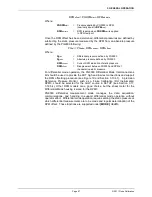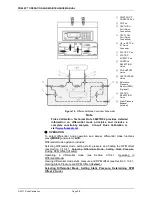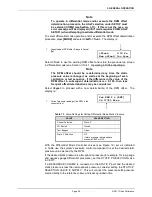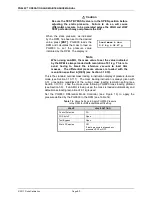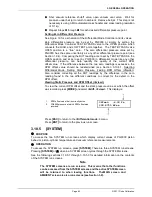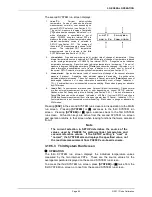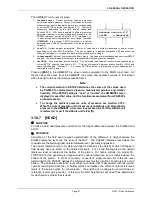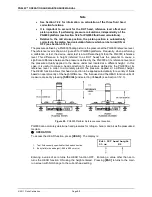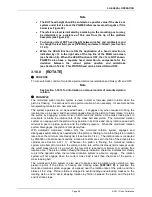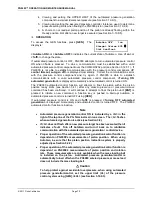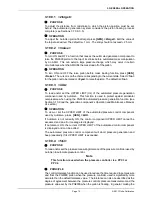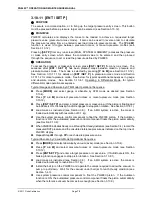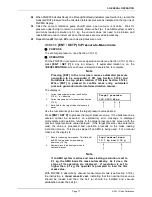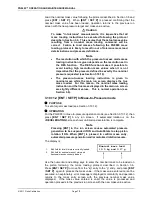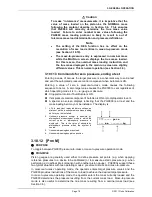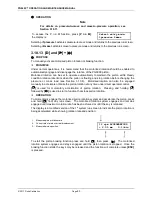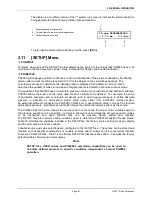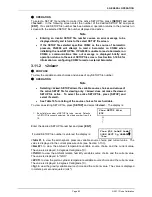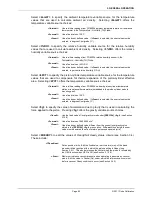
PG9602™ OPERATION AND MAINTENANCE MANUAL
© 2011 Fluke Calibration
Page
70
With automatic motorized rotation OFF, the motorized rotation system engages only when
actuated by the operator. Pressing
[
]
accelerates rotation or
[
]
followed by
[
←
]
stops
rotation (see Section 3.10.13).
Automatic motorized rotation is generally left ON for normal operation. It is turned OFF in
situations where rotation system actuation independent of operator initiative is undesired
(e.g. when performing a crossfloat intercomparison with another piston gauge).
OPERATION
To access the AutoRotate functions, press
[ROTATE]
. The display is:
AutoRotate OFF
1on 2pre-decel
<AutoRotate ON>
or
<AutoRotate OFF>
indicates the current state of AutoRotate. Use
<1on>
or
<1off>
to change the state.
When automated rotation is OFF, the PG9000 motorized rotation system will only engage if
the operator presses
[
] or [
]
followed by
[
←
]
(see Section 3.10.13).
When automated rotation is ON, the automated rotation system engages automatically.
When the piston is floating, it engages as needed to maintain the piston rotation rate above
the
Ready
limit (see Section 3.4.2). When
[ENTER/SET P]
is pressed, it engages to stop
rotation before masses are loaded and/or the pressure is adjusted (this function can be
turned ON and OFF, see Section 3.10.8.1). Manual control using
[
]
and
[
]
followed by
[
←
]
is also still active.
Note
•
Automatic motorized piston rotation is dependent on PG9000’s
measurements of piston position and rotation rate. These measurements
are only available when the mass loading bell is installed on the piston.
Automatic piston rotation is suspended when the current PG9000 mass
load does not include the mass loading bell.
•
Proper operation of the rotation system is dependent on PG9000’s
measurements of piston position. When using AutoGen, be sure that the
piston position indication system is properly adjusted (see Section 5.2.2).
•
When PG9000 is operating in absolute by vacuum mode using the internal
vacuum sensor to measure reference vacuum, automatic motorized piston
rotation will not engage until the reference vacuum value is within the
Ready limit (see Section 3.4.3).
3.10.8.1 <2Pre-Decel>
PURPOSE
To turn ON and OFF a function that causes the automated rotation system to
begin the piston rotation deceleration when
[ENT/SET P]
is pressed rather than
at the time mass is to be loaded.
On a PG9000 Platform equipped with motorized rotation, when AutoRotate is on,
the piston rotation deceleration function is used to stop rotation before masses
are loaded or pressure is adjusted. For larger mass loads, the deceleration
function can take up to one minute to execute. Deceleration can therefore be
initiated the moment that
[ENT/SET P]
is pressed to enter a new pressure or
mass target. The deceleration function then runs while the new target value is
being entered. However, when the next target does not require changing main
masses, it may not be necessary to stop piston rotation. In these cases, running
the deceleration function is probably not desired and it is not beneficial for piston
deceleration to initiate when
[ENT/SET P]
is pressed. For this reason, the
function to start piston deceleration when
[ENT/SET P]
is pressed can be turned
ON or OFF.
If pre-deceleration is ON and AutoRotate is ON, then piston rotation deceleration
always initiates immediately when
[ENT/SET P]
is pressed.
Summary of Contents for PG9000 Series
Page 10: ...PG9602 OPERATION AND MAINTENANCE MANUAL 2011 Fluke Calibration Page X Notes...
Page 128: ...PG9602 OPERATION AND MAINTENANCE MANUAL 2011 Fluke Calibration Page 118 Notes...
Page 164: ...PG9602 OPERATION AND MAINTENANCE MANUAL 2011 Fluke Calibration Page 154 Notes...
Page 188: ...PG9602 OPERATION AND MAINTENANCE MANUAL 2011 Fluke Calibration Page 178 Notes...
Page 192: ...PG9602 OPERATION AND MAINTENANCE MANUAL 2011 Fluke Calibration Page 182 Notes...


